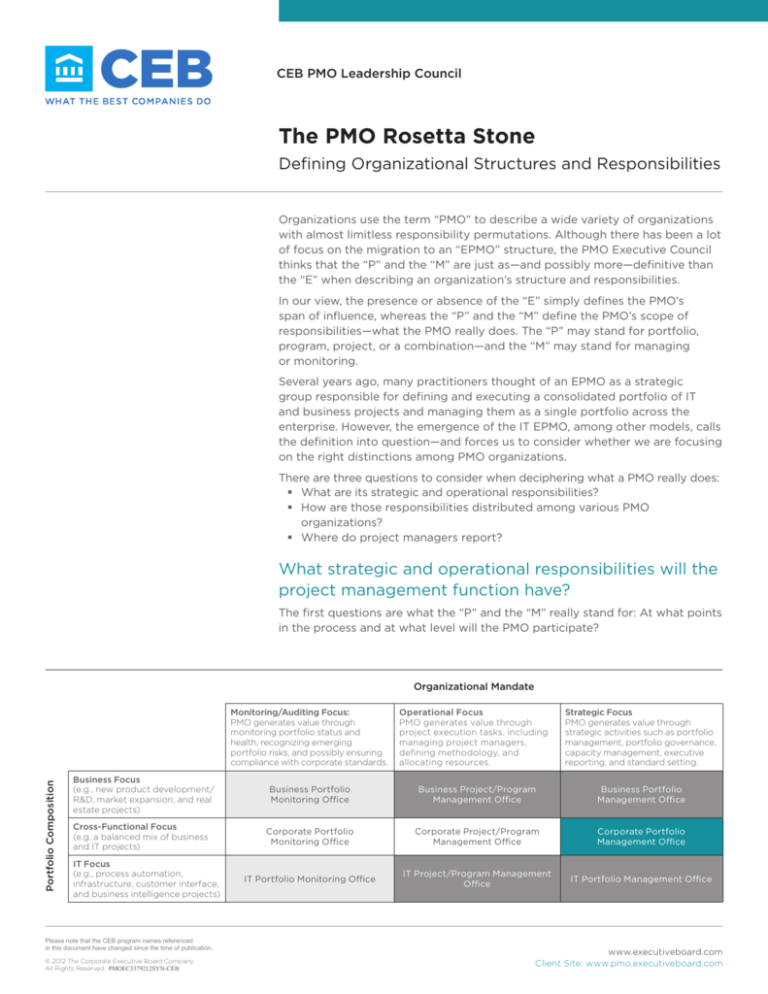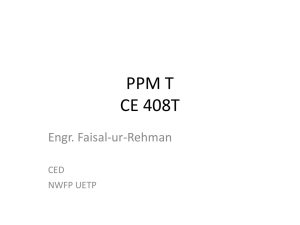
CEB PMO Leadership Council
The PMO Rosetta Stone
Defining Organizational Structures and Responsibilities
Organizations use the term “PMO” to describe a wide variety of organizations
with almost limitless responsibility permutations. Although there has been a lot
of focus on the migration to an “EPMO” structure, the PMO Executive Council
thinks that the “P” and the “M” are just as—and possibly more—definitive than
the “E” when describing an organization’s structure and responsibilities.
In our view, the presence or absence of the “E” simply defines the PMO’s
span of influence, whereas the “P” and the “M” define the PMO’s scope of
responsibilities—what the PMO really does. The “P” may stand for portfolio,
program, project, or a combination—and the “M” may stand for managing
or monitoring.
Several years ago, many practitioners thought of an EPMO as a strategic
group responsible for defining and executing a consolidated portfolio of IT
and business projects and managing them as a single portfolio across the
enterprise. However, the emergence of the IT EPMO, among other models, calls
the definition into question—and forces us to consider whether we are focusing
on the right distinctions among PMO organizations.
There are three questions to consider when deciphering what a PMO really does:
What are its strategic and operational responsibilities?
How are those responsibilities distributed among various PMO
organizations?
Where do project managers report?
What strategic and operational responsibilities will the
project management function have?
The first questions are what the “P” and the “M” really stand for: At what points
in the process and at what level will the PMO participate?
Organizational Mandate
Portfolio Composition
Monitoring/Auditing Focus:
PMO generates value through
monitoring portfolio status and
health, recognizing emerging
portfolio risks, and possibly ensuring
compliance with corporate standards.
Business Focus
(e.g., new product development/
R&D, market expansion, and real
estate projects)
Cross-Functional Focus
(e.g. a balanced mix of business
and IT projects)
IT Focus
(e.g., process automation,
infrastructure, customer interface,
and business intelligence projects)
Please PMO
The
note that
Rosetta
the CEB program
Stone
names referenced
in this document have changed since the time of publication.
© 2012 The Corporate Executive Board Company.
All Rights Reserved. PMOEC3379212SYN
PMOEC3379212SYN-CEB
Operational Focus
PMO generates value through
project execution tasks, including
managing project managers,
defining methodology, and
allocating resources.
Strategic Focus
PMO generates value through
strategic activities such as portfolio
management, portfolio governance,
capacity management, executive
reporting, and standard setting.
Business Portfolio
Monitoring Office
Business Project/Program
Management Office
Business Portfolio
Management Office
Corporate Portfolio
Monitoring Office
Corporate Project/Program
Management Office
Corporate Portfolio
Management Office
IT Portfolio Monitoring Office
IT Project/Program Management
Office
IT Portfolio Management Office
www.executiveboard.com
Client Site: www.pmo.executiveboard.com
The PMO Rosetta Stone
First, we’ll consider the “M.” A sizeable minority of PMOs focus their effort on
portfolio and project monitoring and auditing, without getting involved in project
execution or portfolio selection. In this case, the “M” stands for “monitoring.”
However, the majority of PMOs play a more active role in either portfolio
selection and governance or project execution. In these organizations, the “M”
stands for “management.” The “management” set of responsibilities usually
includes all of the activities that a “monitoring” PMO is responsible for, but the
organizations are occasionally separated to provide a degree of impartiality.
The “P” can be even more problematic. It can represent project, program, or
portfolio; this leads to a real problem in understanding what functions a group
performs when it simply describes itself as a PMO. We believe that the “P”
should be defined by the functions the organization performs—not by where it
reports or the structure of its organizational chart (although those factors are
frequently influential). Consequently, most PMOs are shaped by two defining
characteristics: the portfolio composition and the organizational mandate.
Adding further complication, we often see PMOs spreading their effort over
several of these categories. Project management offices, even those with
an operational focus, usually have a portfolio status and health monitoring
component included among their responsibilities. Occasionally, we also
see larger enterprises with portfolio management offices that retain the
operational responsibilities of the project management office.
Project Portfolio Composition
The primary component is relatively easy to judge. For many PMOs, the
portfolio is dominated by IT projects (which are frequently part of larger
business-facing initiatives). For others, business projects such as new product
development, business expansion, and real estate development projects,
represent the majority of the portfolio. For a very few, the portfolio is a
balanced cross-functional mix.
We often see a progression of responsibilities where the organization starts
with an IT PMO, then mirrors that structure within various non-IT areas, and over
time builds more strategic project and portfolio management competence. We
often see the portfolio management functions for IT and non-IT areas eventually
converge in a corporate portfolio management office, even though project
execution may still be divided across IT and various business units.
Mix of Strategic and Operational Roles
The secondary component is sometimes more difficult to nail down. We
frequently see PMOs commissioned as monitoring and reporting organizations
mature into operational and strategic roles as they build organizational
credibility and competence. They initially focus on establishing a clear line
of sight into portfolio status, health, and performance. As they mature into
operationally focused structures—true project management offices—they
typically focus on the more delivery-oriented facets of project management,
including standardizing methodology, managing talent (even when the PMs
don’t report to them), assigning resources, and enforcing standards and
governance processes. Portfolio management offices usually take a more
strategic view of project management, focusing their effort on shaping the
project portfolio through the selection and prioritization process, the design
of the portfolio governance process, the establishment and maintenance of
standards for methodology rigor and process compliance, and executive-level
relationships within the organization.
Please PMO
The
note that
Rosetta
the CEB program
Stone
names referenced
in this document have changed since the time of publication.
© 2012 The Corporate Executive Board Company.
All Rights Reserved. PMOEC3379212SYN
PMOEC3379212SYN-CEB
2
www.executiveboard.com
Client Site: www.pmo.executiveboard.com
The PMO Rosetta Stone
How will these responsibilities be distributed among
various PMO organizations?
Few organizations fit neatly into one category or another, and there is no
one ideal organizational structure. In fact, most PMOs have an amalgam
of responsibilities in their mandate that span multiple PMO archetypes. In
addition, many organizations have more than one type of PMO—and more
than one of a given type of PMO. The following are descriptions of the most
common organizational structures that we run across; your organization may
or may not resemble these—and your organization may span more than one of
these models. PMOs and EPMOs of similar types are shown together. Whereas
the “E” in EPMO often formerly signified a highly strategic component in the
PMO’s mandate, we are finding that members are using the “E” to simply
denote span of influence across the organization, not scope of responsibility.
In most cases, for instance, an enterprise portfolio management office is much
more similar to a (non-enterprise) portfolio management office than it is to an
enterprise project management office.
The Portfolio Monitoring Office Model
Portfolio Monitoring Office
Enterprise Portfolio Monitoring Office
CEO
CEO
CXO
Business Unit 1
Business Unit 2
CXO
Project
Monitoring Office
Project
Monitoring Office
Project
Monitoring Office
Enterprise Project
Monitoring Office
Project
Management Office
Project
Management Office
Project
Management Office
PMs
PMs
PMs
Business Unit 1
Business Unit 2
Project
Management Office
Project
Management Office
Project
Management Office
PMs
PMs
PMs
For many organizations, the portfolio monitoring office is the first PMO group
that they establish. Responsible mainly for monitoring the status and health
of projects within the portfolio, these organizations frequently expand into
an auditing role over time. In this auditing capacity, they are also responsible
for ensuring that project managers, and sometimes PMOs, are fulfilling the
requirements of standardized practices.
As organizations mature, they sometimes move to consolidate their total
project portfolio reporting effort into one organization—the first version of
EPMO that we regularly encounter. This EPMO—in our language, the enterprise
portfolio monitoring office—aggregates project- and program-level data from
across the enterprise and synthesizes it into a more easily digestible format for
senior management.
Please PMO
The
note that
Rosetta
the CEB program
Stone
names referenced
in this document have changed since the time of publication.
© 2012 The Corporate Executive Board Company.
All Rights Reserved. PMOEC3379212SYN
PMOEC3379212SYN-CEB
3
www.executiveboard.com
Client Site: www.pmo.executiveboard.com
The PMO Rosetta Stone
These portfolio monitoring offices sometimes continue to exist even when
organizations form project management and portfolio management offices;
their function, to monitor and audit, is sometimes seen as a critical capability
that requires some independence from project and portfolio management. It
is not unusual to see a portfolio monitoring office sitting alongside a project
management office and portfolio management office, either in name or form,
within a single organization.
The Project Management Office Model: Setting a Delivery Focus
Project Management Office
Enterprise Project Management Office
CEO
CEO
CXO
Business Unit 1
Business Unit 2
CXO
Project
Management Office
Project
Management Office
Project
Management Office
Enterprise Project
Management Office
PMs
PMs
PMs
PMs
Business Unit 1
Business Unit 2
PMs
PMs
Most organizations establish a project management office structure of some
sort to improve project delivery performance and increase consistency. The
majority of strategic project portfolio activities are done outside this PMO. Some
organizations stick with this structure because of the company’s structure—
federated and independent business units, for example—and others because it’s
uneconomic to move to other organizational structures. Organizations with less
than $30 million in annual project spend within a portfolio often find this model
serves them well over the long term.
Note that most organizations do not have all of these PMOs. Many companies
have only one PMO—an IT PMO—that reports up through the CIO’s
organization. PMs are, as often as not, decentralized and report through the
various business units with dotted-line relationships to the PMO.
In many cases, we see PMOs operating in this structure wearing multiple hats.
While they are nominally tasked with project execution, they are also beginning
to be pulled into many of the strategic activities that a more portfolio
management-oriented leader would participate in. However, the need to attend
to day-to-day project execution responsibilities often prevents the PMO from
focusing enough on strategic activities to develop deep competencies and to
earn the confidence of senior management.
The shift to an enterprise project management office provides organizations
with the opportunity to drive cross-silo standardization and encourage
enterprise-wide resource visibility. Many organizations use this definition for
EPMO, even within a particular portfolio—often an IT EPMO that is responsible
for all IT projects across the organization. Organizations frequently see an
improvement in project quality and efficiency by making this transition.
Please PMO
The
note that
Rosetta
the CEB program
Stone
names referenced
in this document have changed since the time of publication.
© 2012 The Corporate Executive Board Company.
All Rights Reserved. PMOEC3379212SYN
PMOEC3379212SYN-CEB
4
www.executiveboard.com
Client Site: www.pmo.executiveboard.com
The PMO Rosetta Stone
Diverging Strategic and Operational Responsibilities: The Portfolio Management Office
Portfolio Management Office
Enterprise Portfolio Management Office
CEO
CEO
CXO
Business Unit 1
Business Unit 2
CXO
Portfolio
Management Office
Portfolio
Management Office
Portfolio
Management Office
Enterprise Portfolio
Management Office
Project
Management Office
Project
Management Office
Project
Management Office
PMs
PMs
PMs
Business Unit 1
Business Unit 2
Enterprise Project
Management Office
Project
Management Office
Project
Management Office
PMs
PMs
PMs
As organizations mature and project budgets grow, senior executives often
find value in separating strategic and operational project management
activities. Most of our members with IT or business project portfolio budgets
of more than $200 million find it beneficial to separate the activities. The
additional cost of the portfolio management office is offset by the efficiencies
it adds.
Some enterprise portfolio management offices subsume the enterprise project
management office structure underneath them, while others are content to
have multiple project management offices spread throughout the organization.
We often see portfolio management office leaders retaining a small number
of project or program managers within their organization. These “super” PMs
are typically tasked with executing the largest and most strategic projects in
the company’s portfolio and rescuing important projects that have become
troubled.
The Future of Corporate IT: The Corporate Portfolio Management Office
As the largest and most progressive organizations build strong portfolio
management functions for both business and IT project portfolios, they often
find that there are additional scale benefits to realize through collapsing the
portfolio management offices. These organizations place all of their portfolios
into a central corporate enterprise portfolio management office that not
only manages the independent portfolios well, but also finds ways to make
trade-offs and uncover synergies among portfolios. Organizations that achieve
this maturity in project management often find themselves working side by side
with corporate strategy and finance leaders to ensure strategic alignment of
project spend with corporate vision—fully becoming a strategic business partner.
How will project managers be distributed through
the enterprise?
Project manager reporting structures have gone through a number of
transitions over the past few years. Many organizations centralized project
managers to improve the level of standardization across the enterprise
and capture scale and scope benefits. The initial results were very positive.
Please PMO
The
note that
Rosetta
the CEB program
Stone
names referenced
in this document have changed since the time of publication.
© 2012 The Corporate Executive Board Company.
All Rights Reserved. PMOEC3379212SYN
PMOEC3379212SYN-CEB
5
www.executiveboard.com
Client Site: www.pmo.executiveboard.com
According to our research, EPMOs realized up to 11% cost savings. However, EPMO
leaders also soon discovered that their PMs were losing their connection with the
business—and plummeting stakeholder satisfaction in many organizations provided
a call for change. Deploying the PMs back into the business—while maintaining
standards, process, and visibility through the EPMO—is the current trend.
Inconsistent
Standards and
Performance
Increased
Performance
Through
Centralization
Bringing PMs Back
to the Business:
Hybrid Structure
CEO
CEO
CEO
CXO
Business
Unit
Business
Unit
CXO
PMO
PMO
PMO
EPMO
EPMO
PMs
PMs
PMs
PMs
PMs
Siloed organizations provide
locally customized service—at
the cost of enterprise-wide
standardization and efficiency.
Business
Unit
Business
Unit
An aggregated function delivers
standardization—but at the cost of
its PMs losing business context and
diluting relationships.
CXO
Business
Unit
Business
Unit
PMs
PMs
Hybrid structure captures the most
scale benefits while keeping PMs
closely aligned with the business.
Putting the Organization into Perspective
The organization structures profiled here are only a few representative samples
of the wide range of models that we commonly see. The diversity presented
illustrates that PMO organizations come in all shapes and sizes and that those
“PMO” initials can hide a lot of important detail. Rather than focusing on the
differences between a PMO and an EPMO, leaders should focus on the difference
between monitoring and managing, and project, program, and portfolio. Making
sure that there are clear definitions of where each of those sets of responsibilities
lay within the organization is critical to the success of the PMO function.
Please PMO
The
note that
Rosetta
the CEB program
Stone
names referenced
in this document have changed since the time of publication.
© 2012 The Corporate Executive Board Company.
All Rights Reserved. PMOEC3379212SYN
PMOEC3379212SYN-CEB
6
www.executiveboard.com
Client Site: www.pmo.executiveboard.com










